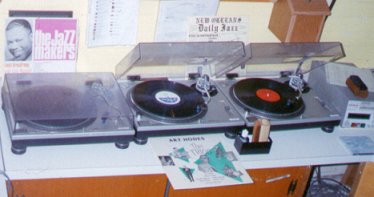Phonograph
From Wikipedia, the free encyclopedia.
The phonograph, or gramophone, was the most common devices for playing recorded sound from the 1870s through the 1980s. Usage of these terms is somewhat different in British English and American English; see usage note below. In more modern usage, this device is often called the turntable or record player. In the late 19th and early 20th century, the alternative term talking machine was sometimes used. The phonograph was the first device for recording and replaying sound.
The term phonograph means "writing sound", a term coined from Greek roots. Similar related terms gramophone and graphophone mean the same thing. Arguably, any device used to record sound or reproduce recorded sound could be called a type of "phonograph", but in common practice it is usually only used to refer to certain historic technologies of sound recording.
| Table of contents |
History
Thomas Alva Edison announced his invention of the first phonograph, a device for recording and replaying sound, on November 21, 1877 and he demonstrated the device for the first time on November 29 (he patented it on February 19, 1878). Edison's early phonographs recorded on a cylinder using up-down (vertical) motion of the stylus. Edison's early patents show that he also considered that sound could also be recorded as a spiral on a disc, but Edison concentrated his efforts on cylinders, since the groove on the outside of a rotating cylinder provides a constant velocity to the stylus in the groove, which Edison considered more "scientifically correct". See also: phonograph cylinderEmile Berliner invented what he called the Gramophone, another device for recording and replaying sound, and patented it in 1888. It recorded on a disk using side-to-side (lateral) motion of the stylus.
British and American language usage differences
In British English "gramophone" came to refer to any sound reproducing machine using disc records, as disc records were popularized in the UK by the Gramophone Company. The term "phonograph" is usually restricted to devices playing cylinder recordsIn American English, "phonograph" was the most common generic term for any early sound reproducing machine. Berliner's Gramophone was considered a type of phonograph. "Gramophone" was a brand name, and as such in the same category as "Victrola," "Zon-o-phone," and "Graphonola" referring to specific brands of sound reproducing machines. The brand "Gramophone" was not used in the USA after 1901, and the word fell out of use there. In contemporary American usage "phonograph" most usually refers to disc record machines or turntables, the most common type of analogue recording from the 1910s on.
Discs verses cylinders on the marketplace
Disc recording is inherently neither better nor worse than cylinder recording in potential audio fidelity. However Berliner's disc technique had commercial advantages over the Edison cylinder system:- Since Edison only patented recording sound vertically in a groove, Berliner did not need to pay royalties when using a lateral groove.
- The disc was much easier to mass produce by molding and stamping, and easier to store.
After years of experimentation, in 1895 Berliner decided he had perfected his "gramophone" system to begin commercial production of his disc records and "gramophones" or "talking-machines" to play them on. These were the first analogue disc records to be offered to the public. From mid the 1890s through the 1910s both phonograph cylinder and disc recordings and machines to play them on were widely mass marketed and sold. The disc system gradually became more popular due to its cheaper price and better marketing by disc record companies.
The dominance of the disc phonograph
Berliner's lateral disc record was the ancestor of the 78rpm, 45rpm, Long Play, and all other analogue disc records popular for use in sound recording through the 20th century. For a more detailed discussion, see analogue disc recordThe "phonograph", or "gramophone", or "turntable" remained a common element of home audio systems well after the introduction of other media such as audio tape and even the early years of the compact disc. They were not uncommon in home audio systems into the early 1990s.
The phonograph in the 21st century
Phonographs or disc record turntables continue to be manufactured and sold into the 21st century, although in much smaller numbers.
Phonograph turntables at a radio station, 2003
Technics were largely responsible for the reinvention of turntables in the late 1960's when they created first direct drive turntable, the SP-10.
One continuing use of the phonograph turntable is "Scratching" in hip hop or rap music.
See also:
External links:

![[Main Page]](/web/20031205045100im_/http://en.wikipedia.org/upload/wiki.png)